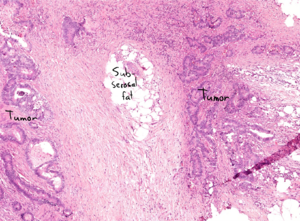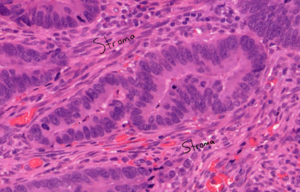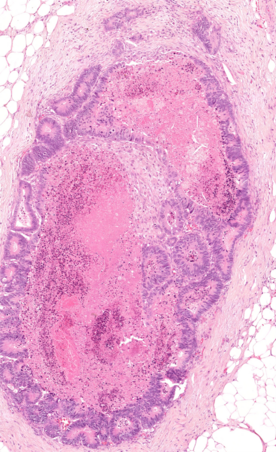6. Rectal adenocarcinoma: Difference between revisions
(Created page with "'''Staining''': HE '''Organ''': Rectum '''Description''': On the leftmost part of the slide is the tissue normal and healthy. In the middle of the tumor can we see a large ulceration. The tumor invades beyond the subserosal fat tissue. The tumor cells only show mild pleiomorphism and they do form tubular structures. The neostroma is hypercellular. In the upper right corner of the slide can we see some lymphovascular invasion. '''Diagnosis''': Rectal adenocarcinoma...") |
No edit summary |
||
| (One intermediate revision by the same user not shown) | |||
| Line 1: | Line 1: | ||
'''Staining''': HE | [[File:Rectal adenocarcinoma - overview.png|thumb|Overview. Because there is a large ulceration in the tumor do we know that the cancer is of ulcerative type.|333x333px]]'''Staining''': HE | ||
'''Organ''': Rectum | '''Organ''': Rectum | ||
| Line 11: | Line 11: | ||
In the upper right corner of the slide can we see some lymphovascular invasion. | In the upper right corner of the slide can we see some lymphovascular invasion. | ||
'''Diagnosis''': Rectal adenocarcinoma T3 | '''Diagnosis''': Rectal adenocarcinoma T3[[File:Rectal adenocarcinoma - hypercellular neostroma.png|thumb|Hypercellular neostroma and tubular structures]]'''Risk factors:''' | ||
'''Risk factors:''' | |||
* Inflammatory bowel disease | * Inflammatory bowel disease | ||
| Line 24: | Line 22: | ||
This tumor invades beyond the muscle and even the subserosa, which gives it the staging T3. The tumor cells only show mild pleiomorphism and they produce abnormal tubular/glandular structures, indicating that the tumor is well-differentiated and therefore low-grade. | This tumor invades beyond the muscle and even the subserosa, which gives it the staging T3. The tumor cells only show mild pleiomorphism and they produce abnormal tubular/glandular structures, indicating that the tumor is well-differentiated and therefore low-grade. | ||
Some of the tubular structures contain dirty necrosis. The tumor is of ulcerative type as we can see a large ulceration in the tumor. The neostroma is hypercellular. | Some of the tubular structures contain dirty necrosis. The tumor is of ulcerative type as we can see a large ulceration in the tumor. The neostroma is hypercellular.[[File:Rectal adenocarcinoma - muscularis propria invasion.png|thumb|Muscularis propria invasion]]Colorectal cancer is commonly associated with mutations in the APC gene or with microsatellite instability. | ||
Colorectal cancer is commonly associated with mutations in the APC gene or with microsatellite instability. | |||
The lymphovascular invasion may in fact be a metastatic lymph node and not a vessel, however we see no lymphoid tissue so a lymphovascular invasion is more likely. | The lymphovascular invasion may in fact be a metastatic lymph node and not a vessel, however we see no lymphoid tissue so a lymphovascular invasion is more likely. | ||
[[File:Rectal adenocarcinoma - subserosal fat.png|thumb|The tumor invades beyond the subserosal fat|left]] | |||
[[File:Rectal adenocarcinoma - mild pleomorphism.png|thumb|The tumor cells (those that comprise the tubular structures) show only a mild pleiomorphism.]] | |||
[[File:Rectal adenocarcinoma - lymphovascular invasion.png|thumb|The lymphovascular invasion. This used to be a vessel, either a lymphatic or vascular one, that is now filled with tumor cells (and dirty necrosis!).|left|452x452px]] | |||
[[File:Rectal adenocarcinoma - subserosal fat.png | |||
[[File:Rectal adenocarcinoma - mild pleomorphism.png | |||
[[File:Rectal adenocarcinoma - lymphovascular invasion.png | |||
[[Category:Pathology 2 - Histopathology slides]] | [[Category:Pathology 2 - Histopathology slides]] | ||
Latest revision as of 13:24, 7 July 2024
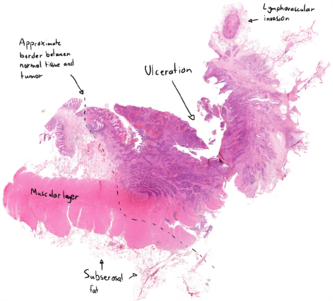
Staining: HE
Organ: Rectum
Description:
On the leftmost part of the slide is the tissue normal and healthy.
In the middle of the tumor can we see a large ulceration. The tumor invades beyond the subserosal fat tissue. The tumor cells only show mild pleiomorphism and they do form tubular structures. The neostroma is hypercellular.
In the upper right corner of the slide can we see some lymphovascular invasion.
Diagnosis: Rectal adenocarcinoma T3
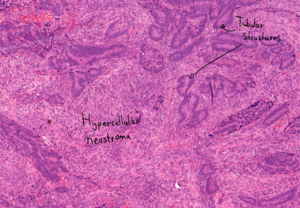
Risk factors:
- Inflammatory bowel disease
- Adenomatous polyps
- Western diet
- Smoking, alcohol
Theory:
This tumor invades beyond the muscle and even the subserosa, which gives it the staging T3. The tumor cells only show mild pleiomorphism and they produce abnormal tubular/glandular structures, indicating that the tumor is well-differentiated and therefore low-grade.
Some of the tubular structures contain dirty necrosis. The tumor is of ulcerative type as we can see a large ulceration in the tumor. The neostroma is hypercellular.
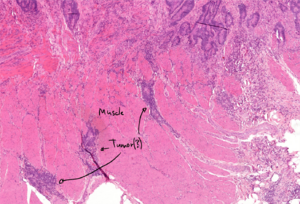
Colorectal cancer is commonly associated with mutations in the APC gene or with microsatellite instability.
The lymphovascular invasion may in fact be a metastatic lymph node and not a vessel, however we see no lymphoid tissue so a lymphovascular invasion is more likely.
